
The Campaign for USC Hits $6 Billion and Keeps on Going
The university surpasses its $6 billion target ahead of schedule—so leaders refocus on grand ambitions and extend the record-breaking drive.
Most mornings, workers arrive before the sun rises over the USC Village construction site. Carpenters and painters scurry to put last-minute touches on dining areas and retail stores, while movers cart furniture to get rooms ready for student and faculty residents this fall.
There’s an air of excitement on campus as opening day approaches. USC Village is the biggest-ever expansion of the University Park Campus, and the most visible sign of the university’s dramatic growth made possible in recent years by the Campaign for USC.
But more significantly, evidence of the university’s remarkable transformation can be found in every corner of its campuses through influential research projects and patient care—as well as in the classrooms, studios and labs where the next generation of scholars, leaders and artists study and dream.
As these campaign-funded changes come to life, you might reasonably ask if the USC community should stop, take a breath from its ascent, and simply enjoy the view for a while.
The answer, according to USC President C. L. Max Nikias, is no. Not yet.
“We are defined by the magnificence of our dreams,” Nikias said in his spring “State of the University” address to faculty and staff. “Why should our dreams narrow while USC blossoms?”
?
THE CAMPAIGN FOR USC HITS $6 BILLION
USC Village is just one of many transformational projects funded by the Campaign for USC—a massive fundraising effort that met its $6 billion goal in late winter, 18 months earlier than expected. The staggering level of support from the university’s trustees, alumni, parents and friends has already made the Campaign for USC one of the most successful fundraising campaigns in higher education.
With momentum on his side, Nikias announced in February that USC would extend the campaign for another five years.
“This is the moment to accelerate our efforts even more,” he says.
I was amazed at the transformation that USC has undergone over the past 30 years. I had to be a part of it by contributing to its future.
Daniel Ast
When first announced in 2011, the $6 billion Campaign for USC—also called Fas Regna Trojae (“The Destined Reign of Troy” in Latin)—was the largest fundraising campaign in the history of higher education at the time. It marked the third occasion that USC had established a record-setting campaign goal.
The launch was roundly questioned by fundraising experts. USC’s goal was just too big, too bold, too “audacious” in a time of national financial instability. Nikias embraced the audacious tag, appropriating it as a rallying cry.
Asked why he would aim so high, Nikias had a simple answer: “Our ambitious vision for USC’s academic future far exceeded our ability to pay for it.” His aim—one shared by the Trojan Family— was to usher the university into the pantheon of academia’s most elite and most influential institutions.
Fast forward to today, and the university has raised as much through the Campaign for USC in 6 1/2 years as it had during the previous 6 1/2 decades combined. Only four other universities—all elite research institutions—have ever raised more than $5 billion to support academic and research priorities through campaigns of varying duration. And in 2013, USC first vaulted into a spot among the nation’s top three universities for annual fundraising, joining Harvard and Stanford—a position it has held ever since.
Campaign funds have helped USC make, in Nikias’ words, “a decade’s worth of academic progress in just a few years.” Extending the campaign will accelerate this dramatic progress, he said.
?
LIFE-CHANGING GIFTS
For many students, donors’ gifts underwrite scholarships that turn the dream of attending USC into reality. USC Trustee John Mork and his wife, Julie, have helped hundreds of top undergraduates study at USC through their $110 million gift to establish and endow the USC Mork Family Scholars Program. Theirs was the largest gift to USC ever for undergraduate scholarships.
Scholarships open doors for students like Jonathan Curtiss, a graduate student at the USC School of Cinematic Arts, who was one of the first recipients of the George Lucas Scholarship last year. The George Lucas Family Foundation made two $10 million gifts in the past two years toward scholarships that will help increase student diversity in the school’s undergraduate and graduate programs.“I wouldn’t have been able to attend USC without it, and my acceptance letter would have just been decoration in my room,” says Curtiss, a native of South L.A. who had turned to a crowdfunding website to try to raise tuition money.
Curtiss also feels a responsibility to pay that generosity forward. “Filmmaking is what I was created to do, and this scholarship means I have fellowship, opportunity and the ability to inspire younger filmmakers in my community to dream without limits,” he says.
?
RECRUITING TOP FACULTY
USC faculty and researchers dream just as big as USC students do, and donors to the university’s centers, institutes and programs provide the funds necessary to make those dreams a reality. Large gifts received during the campaign supported the W.M. Keck Foundation’s naming of Keck Medicine of USC and Keck Medical Center of USC and the creation of the USC Jimmy Iovine and Andre Young Academy for Arts, Technology and the Business of Innovation.
Through campaign gifts, USC donors have endowed 19 new research centers and institutes spanning the arts and humanities, social and natural sciences, and engineering and technology.
By creating 100 new faculty positions since the campaign began, donors have also enabled USC to recruit and retain faculty members who are transforming their disciplines—including stem cell scientist Andrew McMahon, diversity and equity expert Shaun Harper, and brain researchers Arthur Toga and Paul Thompson, just to name a few.
Neurodegenerative diseases like Alzheimer’s and Parkinson’s are some of the world’s most heartbreaking and complex set of illnesses, says Toga, who holds the Ghada Irani Chair in Neuroscience. But funding from the Campaign for USC is creating hope by helping to find treatments and eventually, perhaps, cures.
“I asked for a building devoted to neuroimaging and informatics, and I got it,” Toga says of the new home for the USC Mark and Mary Stevens Neuroimaging and Informatics Institute, which he directs. “I asked for a Siemens 7T—the most advanced MRI scanner in the world, capable of imaging brains faster and at a higher resolution. It arrived. Now we’re able to capture better images of the hippocampus— the memory center—and its connections.”
?
COLLABORATIVE RESEARCH
Adjacent to USC’s track, scaffolding rises around the soon-to-open Michelson Hall, which will be the largest academic building on the University Park Campus. It will house the USC Michelson Center for Convergent Bioscience, envisioned as a research hub for professors, scientists, engineers, students and others working toward a cure for cancer and other diseases. The Campaign for USC has been instrumental in creating opportunities for this cross-disciplinary research.
“We’re taking down walls that have separated experts in different disciplines fighting the same disease. We’re confident that collaboration will lead the way toward solving the most intractable problems of this century,” Provost Michael Quick says.
Convergent research is spurring breakthroughs in health and medical research at USC, but it is also fueling innovation for budding entrepreneurs at the USC Iovine and Young Academy. Last year, students there worked with cancer researcher Peter Kuhn on a new cancer-mapping initiative called CancerBase.
The social media-based initiative allows patients to share real-time data with researchers and other patients that help them understand the progression of their treatment and cancer, says Kuhn, who is a USC Dean’s Professor of Biological Sciences, Engineering and Medicine. It even got a shout-out last year from Vice President Joe Biden during the National Cancer Moonshot Summit.
The Michelson Center and CancerBase demonstrate the kind of innovative thinking and collaboration that attract the continued investment of donors ranging from music industry titans Jimmy Iovine and Andre Young to USC Marshall School of Business alumnus Daniel Ast MBA ’86. Ast was inspired to make his first gift to USC in 2016 after touring campus with his college-age daughter.
“I was amazed at the transformation that USC has undergone over the past 30 years. I had to be a part of it by contributing to its future,” Ast says.
Pushing the accelerator
In the last six years, USC accomplished what it had previously taken six decades to do: raise $6 billion.
Alumni giving totals $2.2 billion so far, driven in part by USC’s undergraduate alumni, who set a new record for giving in 2016. Their giving rate soared to 42 percent last year, placing USC ahead of most research universities of similar size for undergraduate alumni participation and slotting it in first place among all Pac-12 universities, according to the Council for Aid to Education.
In all, more than 328,000 donors have given to the campaign.
“Although USC’s larger gifts tend to make the news, it’s the outpouring of support from alumni, parents, grateful patients and friends from all across the nation and world at all levels of giving that is most inspiring,” says Al Checcio, senior vice president for university advancement.
?
MEDICAL RESEARCH, ARTS AND SCHOLARSHIPS
Continuing fundraising efforts will build on past success, and focus on medical research, the arts and increasing the university’s endowment for scholarships.
“This campaign and its continuation is about what we can do—how we can transform the world—with those funds. The Trojan Family has shown us time and again how much it believes in USC and its potential to better lives,” Checcio says.
The investment made possible by the Campaign for USC is creating a ripple effect in Los Angeles and beyond. A recent independent study showed that USC is one of California’s strongest economic engines. The study found that the university spurs $8 billion annually in economic activity in the Los Angeles region and California.
For many donors, investing in USC provides real impact. And while extending the campaign is a bold move, Nikias and Checcio are confident that university supporters will redouble their efforts.
“While we have an ambitious vision for USC’s future, let’s remember that our dreams have a deadline,” Nikias says. “Let us continue gathering the resources to make them a reality.”



